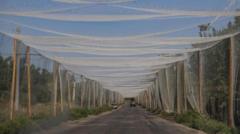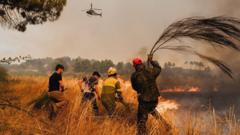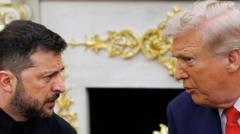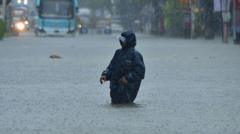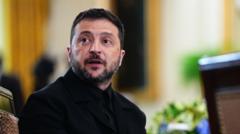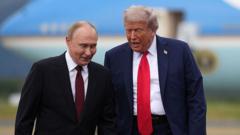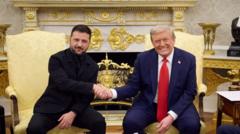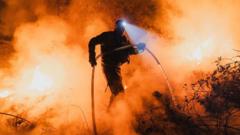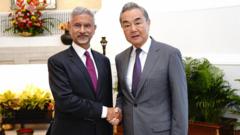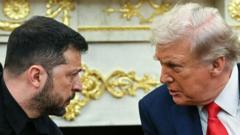As Russia makes territorial advances in the northeastern Sumy region, the prospect of creating 'buffer zones' fuels speculation about strategic military objectives and potential future negotiations.
Strategic Moves: Russia's Advances in Sumy Region Explained

Strategic Moves: Russia's Advances in Sumy Region Explained
Explores the implications of Russia's military operations in the Sumy region of Ukraine and the potential establishment of a 'buffer zone' along the border.
Article Text:
Russian military operations are underway in the northeast region of Ukraine, specifically in Sumy, where local authorities have reported territorial gains by Russian forces. The head of Sumy region, Oleh Hryhorov, indicated that four villages have been occupied, with ongoing skirmishes suggesting a larger strategy to establish 'buffer zones' along the Ukrainian-Russian border.
In a recent statement, Hryhorov disclosed that Russian troops have captured the villages of Novenke, Basivka, Veselivka, and Zhuravka, stating the enemy continues its advancement. Despite these claims, official confirmation from Kyiv has been scarce, with military commentators suggesting that information on the frontlines remains a sensitive subject.
Russian President Vladimir Putin previously articulated a plan to form "security buffer zones" to safeguard border regions adjacent to Ukraine's Kharkiv, Sumy, and Chernihiv territories, although specifics remain murky. According to Russian reports, six villages in Sumy were claimed as under their control.
The lack of confirmation from Ukrainian military officials raises concerns over the interpretation of the situation, as evidenced by limited details in daily briefings that provide vague accounts of clashes along the "Kursk direction." Presidential comments from Volodymyr Zelensky regarding Russia's intentions alluded to preparations for renewed military offensives, which observers viewed as indicative of developments in Sumy.
The Deep State map, a resource which tracks military engagements, confirmed total Russian control over four villages prior to Hryhorov's announcement. Military expert Kostyantyn Mashovets acknowledged a slow advance of approximately one kilometer over the past fortnight, attributing it partly to increased military presence from Donbas.
Colonel Vadym Mysnyk pointed out that Russian operational tactics focus on rapid movements using smaller vehicles to minimize detection from drones, which target larger units. The ongoing aerial bombardment has inflicted significant civilian casualties, with recent missile strikes in Sumy heightening fears of further escalations in violence.
While military evacuations are being conducted in 202 local communities, representing a third of the region, some analysts view the advances in Sumy as part of a broader tactical diversion by Russia. Serhiy Grabskiy argued that by creating pressure in the northern front, Russia seeks to disperse Ukrainian defense resources, potentially weakening defenses elsewhere.
The U.S.-based Institute for the Study of War underscored that successes in Sumy could bolster Russia's leverage in post-conflict negotiations. Nonetheless, experts contend that a major breakthrough in the Sumy region remains improbable due to the stagnated speed of Russian military movements.
Deep State's co-founder, Roman Pohorily, noted that three months into the operations, Ukrainian defenses have stabilized the frontline, suggesting preparedness has improved since the onset of the invasion. Current formations along the border evidence a stronger defensive posture than previously established; however, analysts warn of the potential for changes in Kremlin strategies that could escalate military resources to the region.
Russian military operations are underway in the northeast region of Ukraine, specifically in Sumy, where local authorities have reported territorial gains by Russian forces. The head of Sumy region, Oleh Hryhorov, indicated that four villages have been occupied, with ongoing skirmishes suggesting a larger strategy to establish 'buffer zones' along the Ukrainian-Russian border.
In a recent statement, Hryhorov disclosed that Russian troops have captured the villages of Novenke, Basivka, Veselivka, and Zhuravka, stating the enemy continues its advancement. Despite these claims, official confirmation from Kyiv has been scarce, with military commentators suggesting that information on the frontlines remains a sensitive subject.
Russian President Vladimir Putin previously articulated a plan to form "security buffer zones" to safeguard border regions adjacent to Ukraine's Kharkiv, Sumy, and Chernihiv territories, although specifics remain murky. According to Russian reports, six villages in Sumy were claimed as under their control.
The lack of confirmation from Ukrainian military officials raises concerns over the interpretation of the situation, as evidenced by limited details in daily briefings that provide vague accounts of clashes along the "Kursk direction." Presidential comments from Volodymyr Zelensky regarding Russia's intentions alluded to preparations for renewed military offensives, which observers viewed as indicative of developments in Sumy.
The Deep State map, a resource which tracks military engagements, confirmed total Russian control over four villages prior to Hryhorov's announcement. Military expert Kostyantyn Mashovets acknowledged a slow advance of approximately one kilometer over the past fortnight, attributing it partly to increased military presence from Donbas.
Colonel Vadym Mysnyk pointed out that Russian operational tactics focus on rapid movements using smaller vehicles to minimize detection from drones, which target larger units. The ongoing aerial bombardment has inflicted significant civilian casualties, with recent missile strikes in Sumy heightening fears of further escalations in violence.
While military evacuations are being conducted in 202 local communities, representing a third of the region, some analysts view the advances in Sumy as part of a broader tactical diversion by Russia. Serhiy Grabskiy argued that by creating pressure in the northern front, Russia seeks to disperse Ukrainian defense resources, potentially weakening defenses elsewhere.
The U.S.-based Institute for the Study of War underscored that successes in Sumy could bolster Russia's leverage in post-conflict negotiations. Nonetheless, experts contend that a major breakthrough in the Sumy region remains improbable due to the stagnated speed of Russian military movements.
Deep State's co-founder, Roman Pohorily, noted that three months into the operations, Ukrainian defenses have stabilized the frontline, suggesting preparedness has improved since the onset of the invasion. Current formations along the border evidence a stronger defensive posture than previously established; however, analysts warn of the potential for changes in Kremlin strategies that could escalate military resources to the region.

